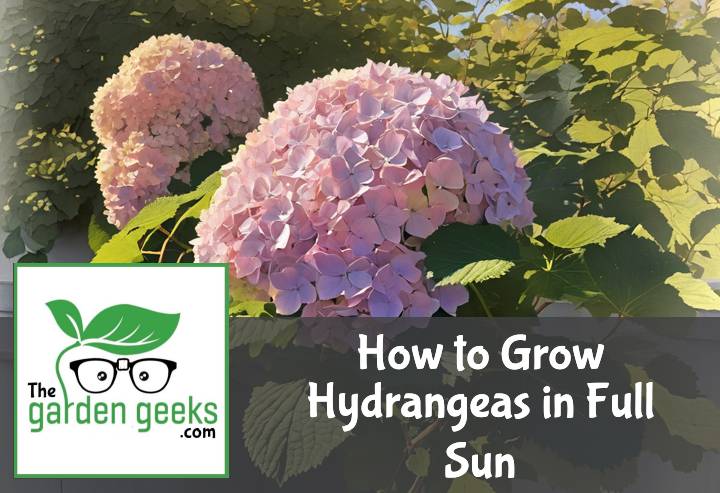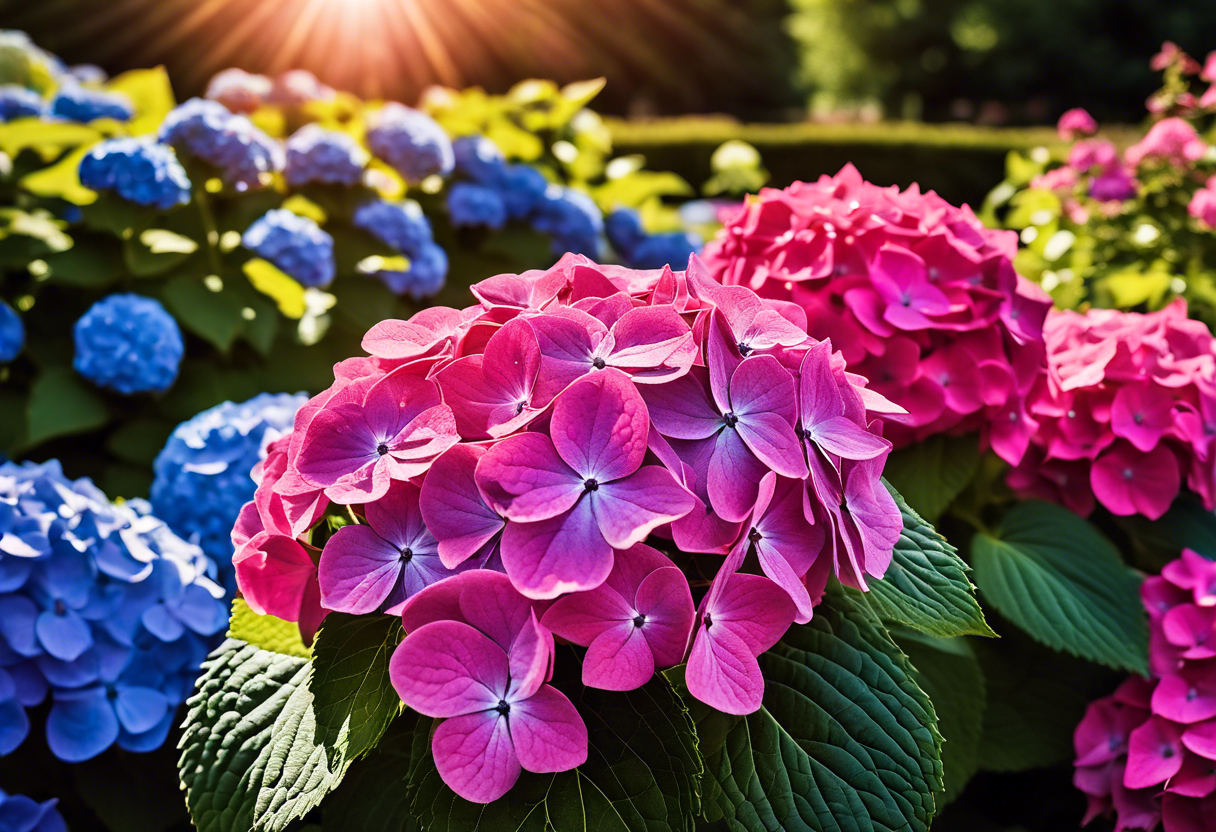Ever tried to grow hydrangeas only for them to wilt under the blazing sun? Trust me, I’ve been there. But don’t fret! As an avid gardener and hydrangea enthusiast, I’ve got your back. Here’s a little secret: learning How to Grow Hydrangeas in Full Sun is not as tricky as it sounds.
With the right tips and tricks, you can transform your garden into a hydrangea haven that thrives even under full sun. So grab your gardening gloves, my friend, because we’re about to dig into some seriously blooming good advice! Keep reading about “How to Grow Hydrangeas in Full Sun (5 Useful Tips)”.
Key Takeaways
- Choose hydrangea varieties that can tolerate full sun, like Panicle and Smooth hydrangeas.
- Plant in well-draining soil to prevent waterlogging.
- Water deeply and regularly, especially during dry spells, to keep roots moist.
- Use mulch around the base to retain moisture and regulate soil temperature.
- Protect from intense midday sun with a shade cloth or by planting near larger plants.
Understanding Hydrangeas and Full Sun
When you think about hydrangea care, the first thing that comes to mind is their relationship with sunlight. It’s a dance, really, between these beautiful flowering shrubs and the sun. But how does full sun impact them? Let’s dive into the hydrangea basics and find out.
What are Hydrangeas?
Hydrangeas, my friend, are a group of flowering shrubs known for their large, showy blossoms. They come in a variety of shapes and sizes – from small bushes to larger tree-like varieties. And let’s not forget about those colors! From blues to pinks and purples, they’re like the chameleons of the garden plants world.
Now, why are they so popular among gardeners? Well, aside from being downright gorgeous, hydrangeas are relatively easy to care for. Plus, they offer an extended bloom time compared to other ornamental flowers, which means more bang for your gardening buck!
How Does Full Sun Affect Hydrangeas?
Believe it or not, full sun can actually be beneficial for some types of hydrangeas. It can promote vigorous growth and vibrant blooms – talk about a win-win situation! However, this doesn’t mean you should just leave your hydrangea under the scorching midday sun without any protection.
On the flip side, too much sun exposure can lead to problems like wilting or even burning (ouch!). This is especially true for certain hydrangea varieties that prefer partial shade over full sun. So yes, while sunlight is essential for plant health, there’s such a thing as too much of a good thing.
In summary then: How to Grow Hydrangeas in Full Sun involves striking a balance between enough sunlight for growth and avoiding excessive exposure that could harm your plants. It’s all about finding that sweet spot, really. And don’t worry – we’ll guide you through it in the following sections!
Selecting the Right Variety for Full Sun
When it comes to learning how to grow hydrangeas in full sun, selecting the right variety is a game-changer. Not all hydrangeas are sun-lovers, so picking a type that thrives under the sun’s rays is crucial.
Types of Hydrangeas Suitable for Full Sun
Let’s talk about some sun-loving hydrangeas. First off, meet Panicle Hydrangea. This tough cookie loves basking in the sunlight and can handle harsh conditions. Then there’s Smooth Hydrangea, another full-sun enthusiast with stunning white flowers.
But wait, we’ve got more! Oakleaf Hydrangea is another variety that doesn’t shy away from sunlight. Its unique leaf shape and beautiful blooms make it an excellent choice for sunny gardens.
Factors to Consider When Choosing a Variety
Now, onto choosing hydrangea variety for full sun exposure. It’s not just about picking any sun tolerant hydrangea and planting it willy-nilly. There are factors to consider!
Firstly, think about your soil type. Some hydrangeas prefer well-drained soil while others don’t mind a bit of clay. Secondly, consider your climate. While many hydrangeas love the sun, they might not be fans of extreme heat or cold.
Lastly, don’t forget about care requirements! Some varieties might need more water or pruning than others. So make sure you’re ready for the commitment before you start digging those holes!
Preparing Your Garden for Planting
Getting your garden ready is the first step in learning how to grow hydrangeas in full sun. It’s all about garden preparation and soil readiness. And of course, picking the perfect spot for those lovely full sun plants, like our star, the hydrangea.
Soil Preparation for Hydrangeas
Hydrangeas are a bit picky when it comes to soil. They love a well-drained, rich soil with a slightly acidic pH level. So, before you start planting, test your soil’s pH. If it’s too alkaline, add some sulfur or peat moss to bring it down a notch.
Now let’s talk about nutrients. Hydrangeas are big fans of compost or organic matter. Adding these to your soil not only provides essential nutrients but also improves drainage – a win-win situation! So remember, proper hydrangea soil preparation is key to growing healthy blooms.
Ideal Location in Your Garden for Full Sun
Choosing the right location in your garden can make or break your hydrangea growing journey. These beauties need at least 4 hours of direct sunlight each day to thrive. But be careful! Too much afternoon sun can scorch their leaves.
So where should you plant them? Well, an eastern-facing location that gets morning sunlight is ideal for hydrangeas. This way they get their daily dose of sunshine without getting fried in the afternoon heat.
Remember folks, when it comes to learning how to grow hydrangeas in full sun, finding that sweet spot with just enough sunlight exposure for hydrangeas is crucial!
Planting and Caring Tips for Hydrangeas in Full Sun
When it comes to how to grow hydrangeas in full sun, a little TLC goes a long way. Proper planting, watering, fertilizing, pruning, and maintenance are key to their successful growth.
Proper Planting Technique
Let’s start with the basics – the hydrangea planting technique. First off, you gotta prep your soil right. A well-drained yet moisture-retaining soil is what these sun-loving beauties crave. Next up is positioning. Your hydrangeas need a spot that gets plenty of morning sunlight but some afternoon shade too. That’s your sweet spot for planting hydrangeas in sun.
Watering and Fertilizing Requirements
Now onto watering and fertilizing – two crucial aspects of full sun hydrangea care. Hydrangeas love water (it’s in the name, duh!). But remember, they don’t like being waterlogged. So aim for moist soil, not soggy! As for fertilizers, opt for a slow-release type that’s high in phosphorus. This will support healthy growth of your sun-loving hydrangea.
Pruning and Maintenance Tips
Last but definitely not least – pruning and maintenance tips for your sunny hydrangeas! Pruning helps maintain shape and promotes blooming. The best time? Late winter or early spring before new growth begins. And don’t forget regular checks for pests or diseases – an essential part of maintaining those gorgeous hydrangeas in full sun!
Troubleshooting Common Problems
When it comes to how to grow hydrangeas in full sun, it’s not all sunshine and rainbows. You’ll likely face a few hurdles like pests, diseases, and heat stress. But don’t worry! We’re going to tackle these common hydrangea problems head-on.
Identifying and Managing Pests and Diseases
First off, let’s talk about those pesky bugs and icky diseases. Hydrangeas are pretty tough, but they can still fall victim to various hydrangea pests and hydrangea diseases. The key is early detection. So keep an eye out for any changes in your plants.
Once you’ve identified the problem (be it aphids or powdery mildew), it’s time for action! Effective pest control isn’t just about squashing bugs; it’s also about preventing future infestations. So remember, when dealing with pest identification and disease management, an ounce of prevention is worth a pound of cure!
Dealing with Heat Stress and Wilting
Now onto the hot stuff – literally! Full sun can sometimes be too much for hydrangeas, causing them to wilt or suffer from heat stress. Recognizing the signs of heat stress in hydrangeas is crucial if you want your plants to thrive.
Wilting leaves? Droopy flowers? These could be signs that your plant is feeling the heat. But don’t panic! There are ways of preventing heat stress and mitigating wilting. For instance, providing shade during the hottest part of the day can do wonders.
And remember, even if your hydrangeas look a little worse for wear after a hot day, they’re tougher than they look! With a bit of TLC, they’ll bounce back from sun damage in no time.
To Wrap Up
Well, there you have it folks, the low-down on How to Grow Hydrangeas in Full Sun. It’s like prepping for a beach day; sunblock (mulch), hydration (watering), and the right gear (appropriate variety) are key!
So, don your gardening gloves and let’s turn those thumbs green! Remember, hydrangeas are not just pretty faces—they’re sun-loving warriors when given the right care. Happy gardening!





